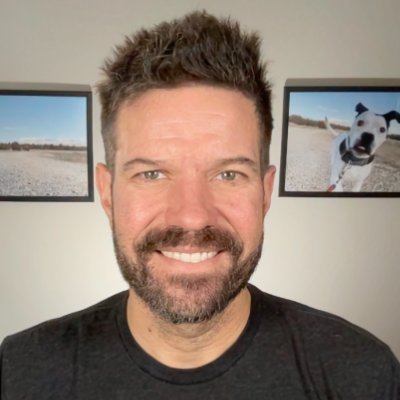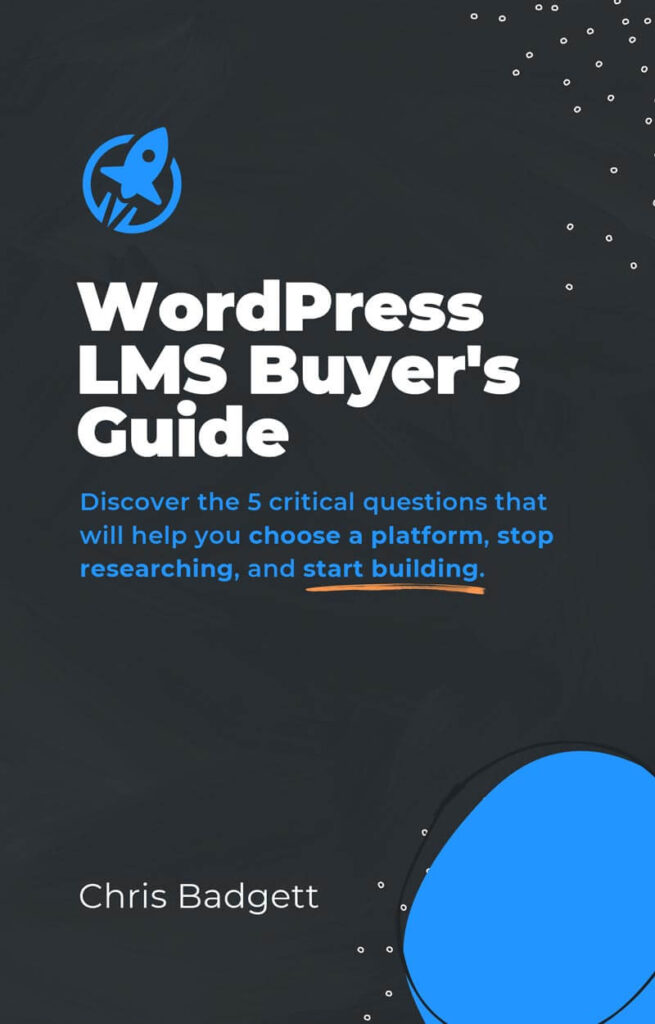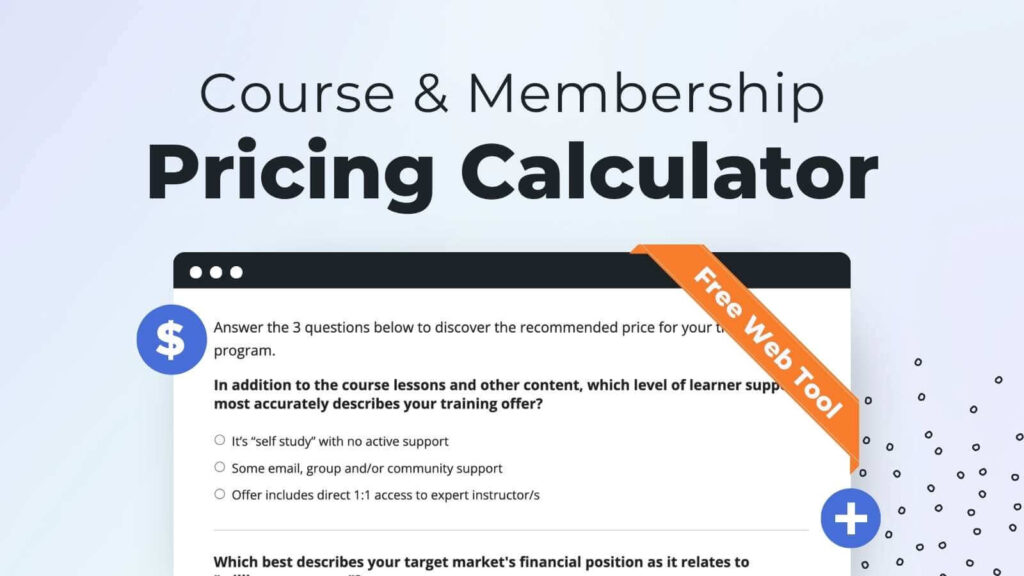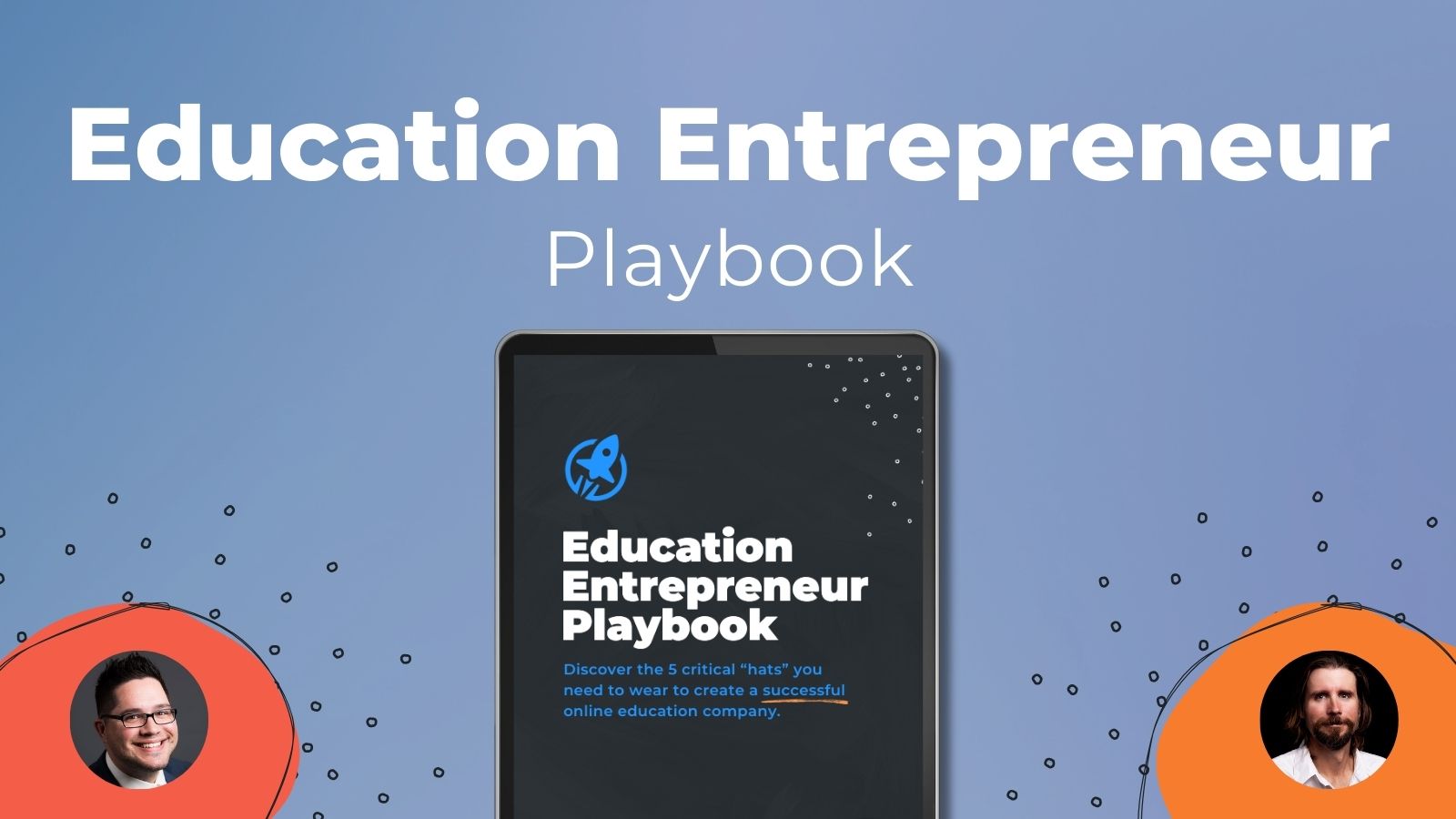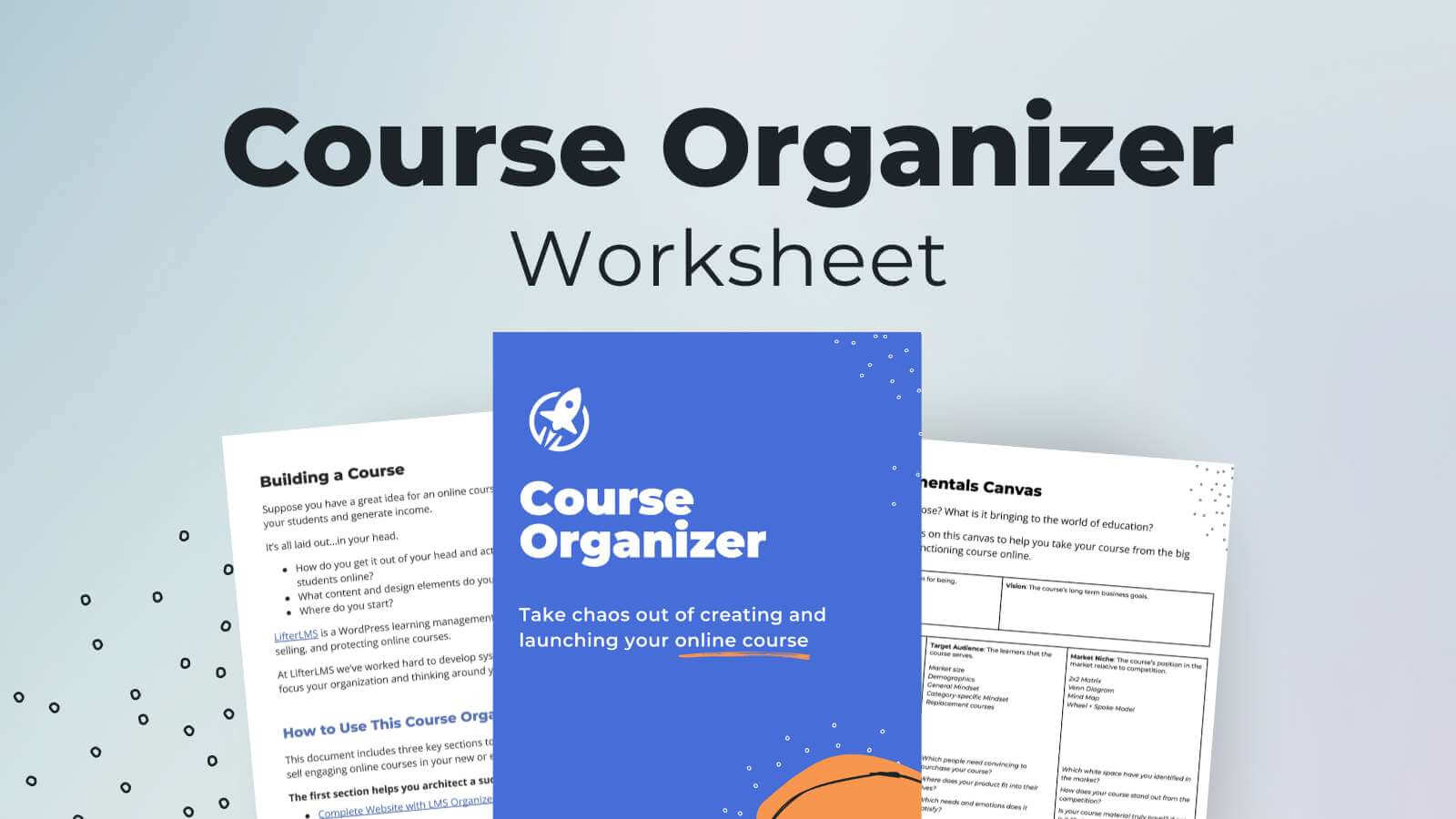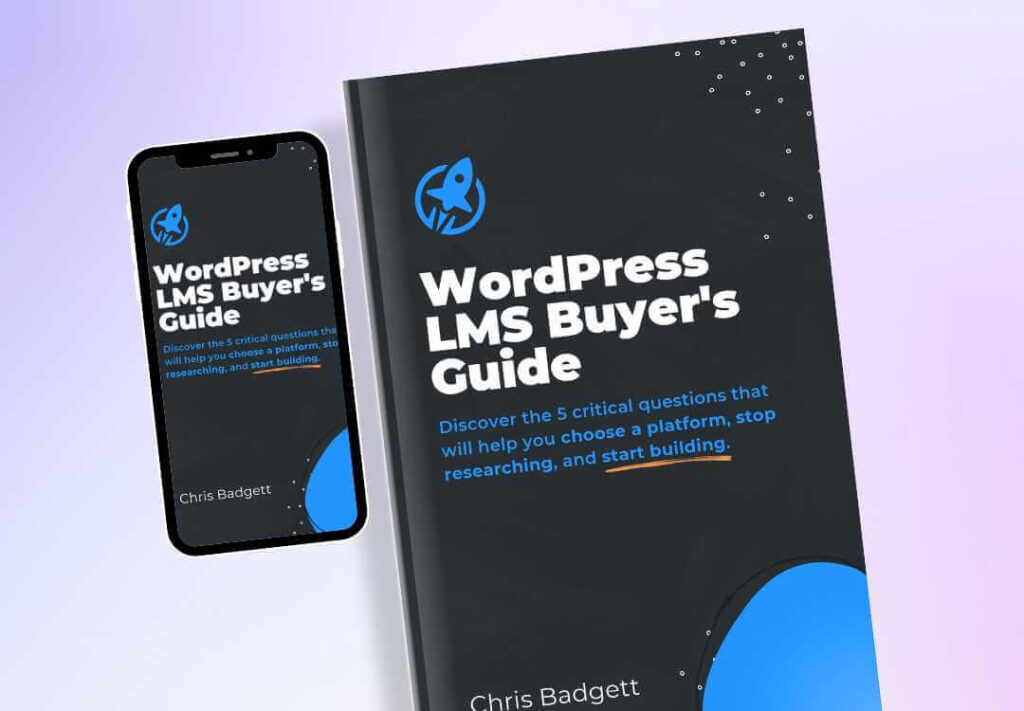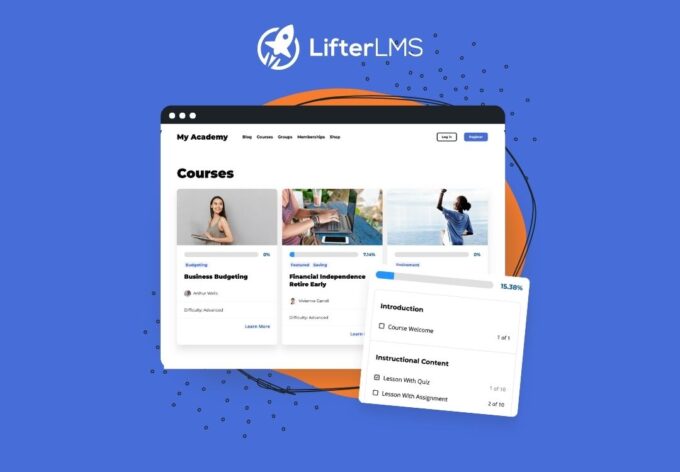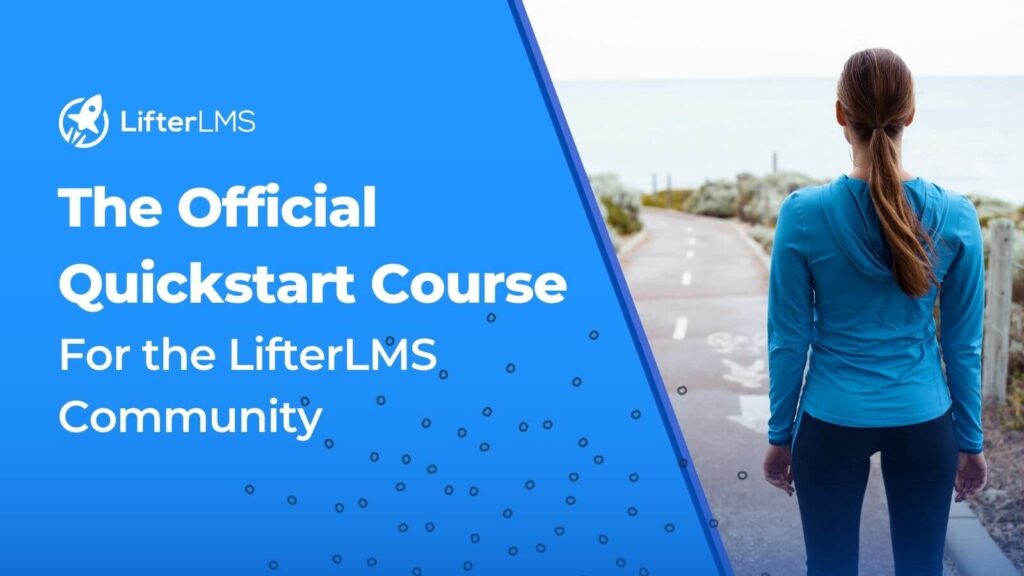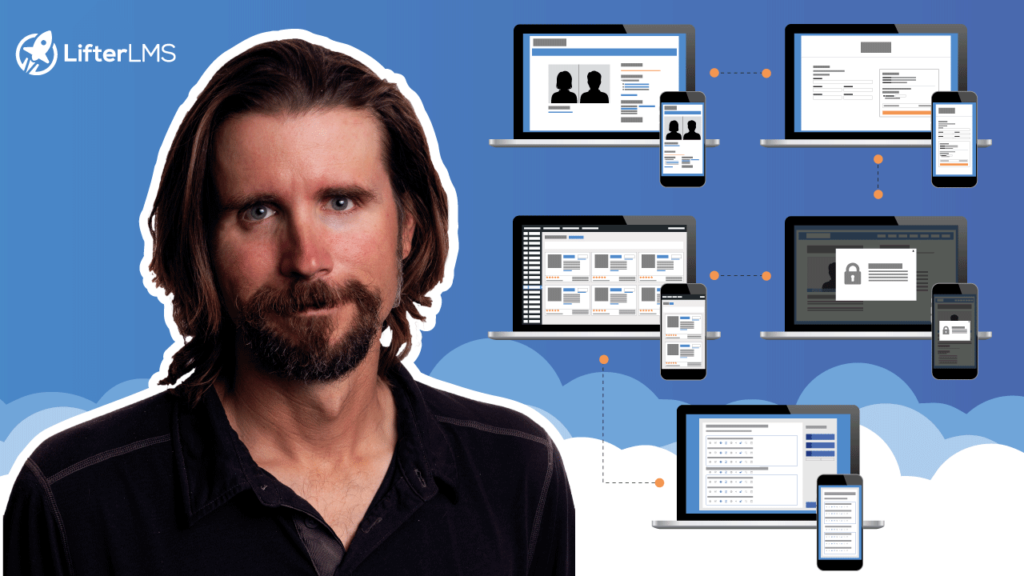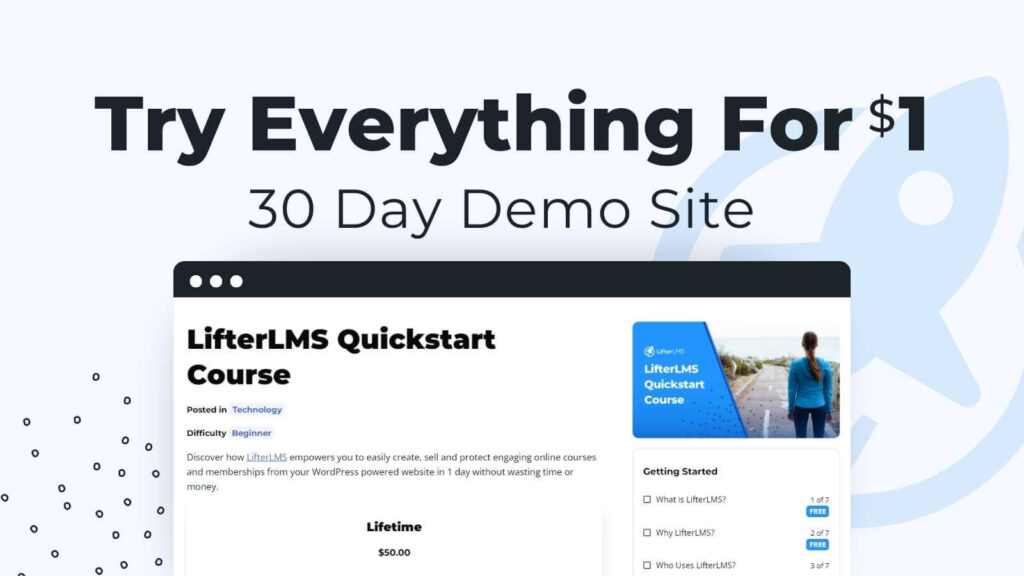If you spend any time in WordPress circles you’ve probably noticed Kinsta’s name surfacing whenever developers talk about stress‑free performance, stellar support, and content that actually solves problems.
In this week’s LMS Cast episode, host and LifterLMS CEO Chris Badgett sits down with Roger Williams.
Roger Williams is the Community & Partner Manager at Kinsta. He’s been in the WordPress community for many years. He unpacks the culture, tech stack, and relationship‑first mindset that make Kinsta stand out. Roger is an expert community builder and loves sharing his best tips with the opensource community.
Here are the biggest takeaways from their conversation.
1. Obsess over useful content, not clicks.
Roger’s Kinsta journey started long before he joined the team. While troubleshooting database errors at a previous job, he kept landing on Kinsta tutorials that explained why an issue happened and exactly how to fix it. That “give‑it‑all‑away” approach to knowledge still drives their marketing strategy, turning blog readers into brand advocates before they ever become customers. Ask yourself: Does our content raise the bar for the whole community, or just chase keywords?
2. Architect for scale from day one.
Kinsta deploys WordPress sites in isolated Linux containers, which lets them move workloads or spin up dedicated machines in minutes. That early bet on containerization—not retrofitted later—means they can iterate fast, roll out new features safely, and protect every customer’s resources. Course creators can apply the same principle: choose infrastructure that won’t box you in when enrollment surges.
3. Feedback loops create product velocity.
Inside Kinsta, team members at every level are encouraged to suggest improvements. Roger recalls submitting migration‑workflow tweaks and seeing them live in production weeks later. When your engineering, support, and community teams share a single backlog, customers notice. Consider building a lightweight process (a public roadmap, a Discord channel, a monthly call) that turns learner frustration into feature ideas.
4. Own your stack—especially your data.
Roger is an unabashed open‑source evangelist. Closed SaaS course platforms may feel frictionless now, but they can lock you out of raw data exports and custom functionality later. With WordPress + LifterLMS you control both the code and the learner records, making it easier to train private AI models or migrate hosts without losing course history. Total cost of ownership beats lowest sticker price every time.
5. Treat community like a marathon, not a funnel.
Kinsta’s support engineers aren’t measured on ticket speed alone; they’re empowered to dig into “out‑of‑scope” plugin conflicts so customers leave each chat with a clear next step. Roger applies the same philosophy to outreach. On LinkedIn he spends more time leaving thoughtful comments than publishing viral posts, because comments spark real conversation and social proof. For in‑person relationship building, start small: attend niche meetups before springing for the 20‑foot expo booth.
6. Leverage video where your audience already hangs out.
Roger repackages his Kinsta Talks interviews as short vertical clips on LinkedIn and full‑length episodes on YouTube. The platform‑native format keeps algorithms happy while driving cross‑traffic via links in the comments (LinkedIn penalizes external URLs in the post body). If video feels daunting, begin with 60‑second insights recorded on your phone; consistency matters more than studio lighting.
Whether you’re shipping your first online course or running a mature membership site, Kinsta’s story is a blueprint for blending technical excellence with genuine human connection. Listen to the full episode to hear Roger’s unfiltered thoughts on AI, the hidden costs of closed systems, and why handing out value for free is the surest way to earn lifelong customers.
Here’s Where To Go Next…
Get the Course Creator Starter Kit to help you (or your client) create, launch, and scale a high-value online learning website.
Also visit the creators of the LMScast podcast over at LifterLMS, the world’s leading most customizable learning management system software for WordPress. Create courses, coaching programs, online schools, and more with LifterLMS.
Browse more recent episodes of the LMScast podcast here or explore the entire back catalog since 2014.
And be sure to subscribe to get new podcast episodes delivered to your inbox every week.
2025 WordPress LMS Buyer’s Guide
Exclusive Download! Stop wasting time and money researching online course and membership site tech.
Episode Transcript
Chris Badgett: You’ve come to the right place if you’re looking to create, launch, and scale a high value online training program. I’m your guide, Chris Badget. I’m the co-founder of lifter LMS, the most powerful learning management system for WordPress. State of the end, I’ve got something special for you. Enjoy the show.
Hello and welcome back to another episode of LMS Cast. Today we have Roger Williams, who I just met at a conference in Arizona. Roger is the community manager and partner manager at Kenta hosting one of the top hosts we recommend at Lifter LMS. He also has done a lot of things in the tech space. Uh, he’s got a fun, interesting lifestyle.
We’re gonna get into that. But first, welcome to the show, Roger.
Roger Williams: Hey Chris. Thanks for having me on the show. I’m excited to be here.
Chris Badgett: Well, tell us about Kinta. I can. The, one of the things I love about Kinta is I see people use it, and I never see anybody complain about it. So something is going on there. You guys are doing something right, people are happy.
But what is the kinta difference? What do you love about it? What, uh, you know, what makes it different in the space?
Roger Williams: Yeah, man. Thanks for the great question and, and teeing me up here. But, uh, yeah, so Kinta, you know, I, I’ve gotta say it’s one of the most unique working experiences, uh, I’ve ever had. Um, I found a company when I was working at another hosting company in tech support, and the, what happened was, is that every time I would Google, like, you know, some sort of database issue, right?
Would be the most common problem. I’m, I’m trying to help a customer. They got this weird error. So I go to Google it. And time and time again, this blog kept coming up with the perfect answer, right? It wasn’t just like, oh yeah, here’s the problem. It was like, here’s the problem, here’s why it’s happening, here’s the steps to resolve it.
And that blog was considered.com. Um, and, and it just, it was again, and, and again and again for all these different problems. And so. I was like, man, this is a really interesting company, right? They’re, they’re willing to put all of this knowledge out into the universe for anybody to use it. They don’t have to be against a customer.
And it was just really helpful stuff. And so I, I applied to go work there. And they actually didn’t hire me, uh, for tech support. I wasn’t, I wasn’t good enough. I, there was a specific question about file permissions that I just totally messed up. And so, uh, but they were looking for migrations engineers and so I, I got hired doing migrations.
And, you know, I quickly like realized this is a very different company for a few reasons. Um, the, the big one for me was feedback. I, I’ve worked at a lot of companies and I’ve had ideas for like small improvements and some bigger improvements, but definitely like smaller ones that specific to like the task that I’m doing.
And in migrations, right, you’re. You’re interfacing with different hosts and all these, you know, there’s just a lot of stuff that changes all the time and I was able to like, give feedback to my manager and the stuff got implemented. That just maybe I haven’t worked at really good companies, uh, that much.
But, um, that was really unique, uh, for me to experience where I could give feedback, whether it was to my boss or straight to the engineering team, right. About the product, about the dashboard and, and stuff. And they would actually, you know, if it was a good idea, they would actually implement it. And so, you know, just all these things kept happening like that, that just made me really realize like.
We really talk, we’re walking the talk, right? A lot of companies say that they’re really interested in taking care of their customers and their employees. Um, but at, at Kinta, like I really do see that difference. And, and you know, you pointed out, you said some nice things there about you’ve never heard anybody I.
Complaining about Kinta, and I think that there’s a few reasons for that. Um, the first one is we’ve built our dashboard from the ground up, um, around people managing WordPress websites. And so, you know, we’ve taken, our engineers have taken from their own experience of doing this and then also feedback from different developers and, and people that are using the service and they’ve built this dashboard that we’re able to iterate on.
And so since we’re not using somebody else’s dashboard, if there’s a change that needs to be made, we can just make that change. And I see this happen again and again. I mean, since I’ve been here for just over five years, I. We’ve done a complete revamp of the dashboard in that time, not only from a look and feel, but also from the code base behind running it.
And, and they did that to help anticipate the things that we would be doing in the future. And so they’re able to iterate really quickly on things. So, so there’s, the service is really good. Um, but then on top of that. The support is really amazing. Um, we have a really good team of leaders that understand how support works.
Like they’ve been in the trenches, they’ve been on the chats and, and dealing with customers so they know what a support engineer goes through. And they’ve created a really good system where, you know, the engineers get amazing training and then they’re really encouraged to. Work with the customer and get to know the customer and help them and understand their problems and realize that even, even if it’s an outta scope support issue, right?
Like for instance, like code, like we’re not developers, we’re not gonna go in and touch your code. We want to get as close as possible to some sort of resolution for you so that when you get off the chat, you’re able to go, okay, hey. You know, either this plugin or this specific line of code is causing some sort of an issue.
And I can either as a developer, work on it or I can get a developer to work on that. And I think, I think that is a really big difference from how a lot of other companies run support, where you know, hey, it’s not our problem. Uh, you know, go figure it out. We really don’t want to say it’s not our problem, even when it isn’t our problem.
And I, I think that that makes a really big difference for customers. So, uh, long-winded answer there. Um, but, and I can keep going on for days, but, um, yeah, it, it really is definitely a unique place.
Chris Badgett: Yeah. But I mean, you can just tell the brand the feel like in the market it’s, and that comes from somewhere.
Roger Williams: Yeah. And,
Chris Badgett: uh. I often hear also a lot about kin’s content, like you’re saying, lots of helpful content. It’s what you found. And, um, I know, uh, I remember listening to an interview, I think with Brian Jackson a long time ago, who did a lot of great content work there and, you know, and he’s a big leader in good content and SEO and all of that.
It’s, um,
Roger Williams: yeah,
Chris Badgett: yeah, it’s off.
Roger Williams: Brian. Brian, Brian was with us for a long time. You know, he’s still a big supporter with us. Um, he needed to step back from the marketing role, but, um, yeah, he really pioneered, uh, for our teams, you know, this approach of creating really useful content that, that the marketplace is looking for.
And so really trying to solve a need there. Um, but you know, it goes all the way back to the founders when they were in their apartment getting it started. Um. Just, you know, realizing like, Hey, we’re going to build a really amazing product. And part of that was, you know, starting to use Linux containers for every site to really help make ’em more bombproof, um, and scalable as well.
Right? We, we can easily move those containers around if we need to, if you need to go to a dedicated machine. It takes very little time for us to provision and get you moved around. And so I think there’s some of these fundamental aspects of our technology and the decisions made early on that have really paved the way for the, the, you know, the great product and service that we’re offering today.
Chris Badgett: I know you’re a big open source fan, so somebody out there is watching or listening and you know, they, they wanna make a course, they haven’t really decided where they’re gonna put it. Yeah. Um, you know, there’s hosted solutions like Kajabi or Teachable or Thinkific. But then there’s options to have the website yourself and use WordPress and tools like Lifter, LMS and the other ones.
Roger Williams: Hmm.
Chris Badgett: What? Why are you such a big open source advocate, and how do you feel about it?
Roger Williams: Yeah, man. Great question again, and, and a big question. Uh, I think that open source software is one of these, uh, inventions, revolutions, what have you, that not enough of society really understands how fundamentally different and important this is.
Um, you know, with open source software, you, you can see all of it and everybody can see all of it. And so. If there’s a huge network effect, um, with that, it, you know, with, when you have closed source software such as like Microsoft or Apple, nobody can see that code and so they can’t see when there’s a problem in the code and point that out.
To Microsoft or Apple of, Hey, you know, here’s the, here’s a problem I found and here’s a solution. And with open source, anybody can come along and do that. And you know, for a lot of people, the quick reaction’s gonna be, well, if the code’s exposed, then all these bad actors are gonna be able to identify that and take advantage of it.
And, you know, that’s not an incorrect statement that that is accurate. But the, you know, my, my belief is that humans are at. Full nature or regular nature, just good people. And so the majority of people are gonna point out, Hey, there’s an issue here. You should fix it. Um, and if you flip that on its head and you say, Hey, with Microsoft product, if there’s a security exploit and somebody discovers that.
There’s no place really. It’s not an easy way for them to disclose that to Microsoft. And so you’ll have just as many bad actors taking advantage of things, uh, in that case as well. And I think the open nature to it, uh, you know, trying to get back on track here, the open nature to it tends itself towards people being able to help.
I think that’s, that’s the exciting part about open source software is the community part. Um, you know, there’s, there’s a whole group of people coming together to, you know, there’s a smaller group that actually works on the software. Usually. Sometimes it’s just one person, but then you have a community of users around it and they’re giving feedback and they’re testing and, you know, all of, all of this stuff that helps the developers.
Continue to work on the project. So kind of, you know, short cutting a little bit here and talking about, you know, when you’re going to go and build a learning management program. Um, why open source is a, is a, a better way to go. I. You know, there, there might be more cost on the front end, um, either in terms of time of setting it up or you need to hire a developer to help set things up.
Um, you know, with open source software, that is a reality. And, and you know, it’s good that we don’t hide from that, but you fully own the solution. You have, you have complete access to that code. So if you’re a developer, you can get in there and mess with it. You can hire developers. To do anything you want to it.
Um, and so you own the code, but you also own all the data and, you know, there’s, it’s all about the data anymore, you know, in terms of your customer’s information, the actual, uh, course that you’re building and sharing, and. When you’re using a closed solution, you don’t have access to hardly any of that. Um, you know, there’s a lot of times I’ve seen with these closed source solutions, you can’t even really export the data out at all.
So if you wanted to at least get something out of it and move somewhere else. You’re gonna have to build everything again from scratch. Um, and so that little bit of savings you had up front for the convenience of just clicking a button and getting started, you know, down the road when you’re five, 10 years down the road and you’re making serious money because you’ve made a really great course, you’re very successful.
Um, now you’re, you’re hitting the, you know, the, the restrictions of whatever that. Software is that you were using or worse yet, the business that was building that software was mismanaged or they get sold to Adobe for, you know, worst case scenario is that when Adobe buys your software, ’cause it’s probably gonna go away and you have no control, you have no recourse over any of that.
And with open source software, something like WordPress using L Lifter, LMS. You have full control because it’s your code and you know, if you’re not happy with the host that you’re at, you can move on over to Kinta and, you know, have all those options to find better service. So, you know, I can keep going for days about, um, you know, the philosophy behind why open source software is better than closed source.
Um, but I think, you know, really thinking in terms of ownership and total cost of ownership is a great place for people to start.
Chris Badgett: That’s awesome. And one of the things that gets me excited is, and I don’t know exactly where we’re going with open source and artificial intelligence, but like you mentioned, because it’s open, um, anybody could leverage AI tools and create all kinds of innovations, modify the code with ai, even if you’re not a developer.
Like this is the world we’re coming to, you know, web hosts as an example. I could, like, I, I’m also, I like free open source as well, and we have free and premium Sure add-ons. But the, if something’s open source and it’s free and it’s just sitting up here on the entire internet for AI to take a look at and do whatever they want to do with it, it’s really powerful concept.
Whereas like closed source software. People who work in that company are probably using AI tools to help write code and stuff, but it’s not open to the world. Mm-hmm. And that’s such a, a big idea. Any, any artificial intelligence thoughts in open source overlap for you?
Roger Williams: Yeah, no. 100%. Uh, big shout out to Victor Ramirez.
Uh, he’s a really awesome, uh, developer. Does a lot of work with WordPress and stuff, and I saw him at Word Camp Phoenix, uh, 2024, and he had a really great talk about. Why WordPress is perfectly positioned for large language models and these AI tools because again, you have total ownership of the data. So if you want to give this data to a large language model or you want to grab something like llama, right, the, the open source, um, LLM from um, uh, Facebook, you know, you can now create your own private LLM.
With your data in it, and you have full control over what it says and what it shares and what it doesn’t share, whereas, you know, if you’re going out to use open AI or, or you know, some of these different, uh, closed source LLMs, you don’t have as much say in terms of what data they’re collecting. And as we evolve into using these tools more and more and as companies realize the benefits of bringing these tools in, I think there’s going to be a big wake up call, um, where people realize if they don’t own their data, I.
They’re, again, they just don’t have the control over what’s being shared into these systems, how it’s being used in these systems. And, you know, with a, with an open source tool like WordPress, you do have all of that control. And so I think, I don’t have a great exact answer for all this stuff yet. I would definitely follow Victor.
Um, he, he’s putting out really great content. There’s a lot of people talking about this stuff that are a lot smarter than me. Um, but we’re seeing it happen and it’s, it’s very exciting. Rich Tabor had a really great presentation at Press Comp. Talking about how he’s using AI and how he’s using it in WordPress.
And again, because you have the ability to go in and and work with the code within WordPress and adapt it to what you want to use these tools for, you just have so much more freedom.
Chris Badgett: Yeah. Exciting times. And it’ll be an interesting by or decade from here.
Roger Williams: Yeah.
Chris Badgett: Um, one of the things we talk about on this podcast a lot for course creators and education entrepreneurs is build the power of building community.
You’re a community guy in your job title at Kinta is community manager. Yeah. What’s some advice you have for people who are trying to get out from behind the computer in their niche and participate, but also maybe intentionally build community like. How do we do that?
Roger Williams: Yeah, it’s a, it’s a great question.
I, I wish I had, uh, all of the answers for you. Um, you know, it’s in my title, so obviously I must be an expert, uh, is not accurate. Um, I, I think having a beginner’s mind and realizing, uh, community is, it can be challenging, but, you know, take small bites. So for example, I think getting onto social media. Is, is a great first step for building community.
Um, there’s already people out there talking about, maybe not your exact course, but they’re talking about something related to your course and you can start interacting with them. Um, I think, you know, tools like Reddit. Are pretty amazing also because of how much they’re getting pulled into Google search results and also these LLM tools.
So you can kind of get some little double dipping there where you’re getting community plus some SEO um, you know, if you’re doing a a B2B course, you know LinkedIn, um, there’s, there’s all these different social media platforms out there you should be using and, and you can get the two-way feedback going.
And so I think that that’s really great. I think interviewing people that have re something related to what you’re trying to teach, uh, is a great way to get started with that because now you’re bouncing off of somebody else’s ideas. You’re, you’re gaining from their experience and you’re sharing that with your community, and I think there’s a huge benefit to that.
I get approached all the time on the interviews that I’m doing. Uh, with people, uh, when I go to events and, and people are like, Hey, I, I’ve been watching your podcast. It’s really great and, you know, thank you for, you know, the, the great interviews and. And so that, you know, that always catches me off guard just a little bit.
But it is really powerful and, and, and interesting. So then the second stage is talking about like going to actual in-person events and interacting with people. And I think starting small again is really important here. Don’t think that you need to go and buy the biggest booth or even a booth at all.
Like just start going to the events that have. Some sort of relation to the course that you’re doing, uh, whether it’s an industry event or just a, a general get together of, of people around that topic and start interacting with people and, and connecting with them and connecting with them on social media and taking those relationships and, and extending them beyond.
Just meeting in person, but it, it’s, you know, getting that salesman, it’s a sales mentality too, as well. Right. Or even a marketing mentality in that you really need to be putting yourself out there. You need to be not afraid to make a mistake and sound stupid. Um, because first of all. Most people aren’t paying attention that close.
Um, and, and like people are focused on themselves. Uh, so, so don’t, don’t get too hung up on making a mistake and, and sounding or looking stupid. Uh, it might, it, it’ll happen. I mean, it’s inevitable. It’s gonna happen. We don’t. We don’t all know, uh, everything that we’re talking about, especially when we’re first starting.
Um, and also that’s gonna be a great way for you to learn is when somebody corrects you and, and now you’ve, you’ve learned something new and maybe you won’t do that mistake again. Um, you know, just. Really enjoying it and then learning really to enjoy talking to people and listening to people. So I think, you know, the sales and marketing, we’ve, we’ve talked about this in, in other conversations, uh, I think sales and marketing is, is really integral, uh, especially for a business.
Um, obviously you need to sell your product, but really, you know, going beyond just the. You know, I need to close this deal right now and realizing you’re building relationships. Uh, and not everybody’s gonna be a customer right now, but they might be in six months, they might be in a year. And just seeing every opportunity, every relationship as an opportunity to just connect with somebody.
And maybe down the road something will come of it, but at least in the meantime, you’ve made a new connection with someone, uh, learned their perspective on the world. And maybe you can take that, uh, into your business.
Chris Badgett: I love that. That was, that was a masterclass and it’s, I love what you said about just get out there, start with social media.
We can all do that. We’re probably already doing that, but do it with maybe a little more focus. Mm-hmm. Um, yeah. You know, your net worth is your network kind of thing. Like you can’t always measure everything. Yeah. Like it’s almost a meme in our space, as with like WordPress companies, product companies, hosting companies.
If you get asked a question, what’s the ROI of sponsoring or attending a Word camp or conference? Like, I don’t know man, but I’ve, I’ve met some great people and you know, things evolve and we’ll see. Uh,
Roger Williams: yeah, no, it’s a really great point. You know, and, and, and it’s something I need to get better at is the whole measurement.
I need to get better at making sure I’m putting my UTMs into my links and I, I know I need to work on that. But my, my suggestion in going with what you’re kind of talking about here is be careful with how much you’re focused on ROI in relationships and with community because, uh, it, it’s very, it’s much more organic.
It’s very transparent, right? Like, people will know when you’re trying to sell them. And, and so you need to, you need to take like a slower approach with that. Um. And, but you know, you can still use those sales tools in the back of your mind, like, you know, try and leading conversations in different directions and whatnot.
But you know, for the most part, you’re really just trying to connect with people and I. You know, learn more about what their challenges are, you know, and, and you know, and you might not be able to actually help them with that, but you might know somebody else who can. And so making sure that you’re building referrals up and just showing people that you’re there to actually try and help them and not just make a, a buck off of ’em, that goes a long way as well.
Chris Badgett: This episode of LMS Cas is brought to you by Popup Maker, the most powerful, trusted popup solution for WordPress. Whether you’re selling online courses or memberships, popup maker helps you grow your email list, boost sales conversions, and engage your visitors with highly customizable popups. Imagine creating custom opt-ins, announcements and promotions that actually convert.
I personally use pop-up maker on my lifter LMS websites for lead magnet opt-ins, card abandonment, upsells, downsells, and guiding users to helpful content. Popup Maker is an essential tool for growing my email list and making more money online through my website. Ready to take your website to the next level?
Head on over to wp popup maker.com/lmscast and save 15% on your order. Discount automatically applies when you visit through that link. Papa Maker also has an awesome free version, so you can just use that as well. Go to wp popup maker.com/lmscast and save 15% off your order or get started with the free version.
Now. Get more leads and sales on your website with popup Maker today. Now back to the episode.
Yeah, that’s awesome. You mentioned getting on social media and um. You’re active on LinkedIn and other places. I feel like many of us, sometimes we have our primary, like I’m a primarily a Twitter person and my company’s more primarily YouTube when it comes to, which is kind of like social media with the comments.
But uh, and we have like a big Facebook group or whatever. But the funny thing about social media is. People often say, oh, like Facebook’s dead, or LinkedIn, there’s too much DM, spam, or whatever. Like, Twitter’s dead, but they’re not. You just gotta learn how to drive it. So what? Take us to school on LinkedIn, how you use it, what you like about it, and just advice for people looking to grow, influence, and just participate in a social network like LinkedIn.
Roger Williams: No, absolutely. Uh, you know, I’ve been on social media off and on for a long time. I think I signed up for my Twitter account in like 2007 or something silly, and I used to really be big on Twitter and then I got burned outta that. I was big on Facebook and I got burned outta that. And I think one of the big reasons that I like LinkedIn is it’s about business.
And so. There’s a lot of times on like Twitter and Facebook, these other social media networks where you’ll start wanting to do a business type of thing and people will get really upset and, and you’re like, okay, I’m sorry. I didn’t, I didn’t know. Whereas on, on LinkedIn, it’s like everybody is there for the purpose of doing business and so like, you know.
It’s just expected that you’re going to be talking about your product and you’re going to be talking about, you know, maybe a business idea or a methodology or sales technique and things like that. And so I really like that because I’m at the point now in my life where I don’t really need social media to like fulfill.
Personal things. Um, you know, I’ve got, I’ve got my wife, I’ve got, you know, friends and all family and all that type of stuff, and, and I really try and disconnect as much as I can. But when I’m working, LinkedIn is where I’m at because I can connect with all the people that I, either I’m doing business with or I’m partnered with or I’m in a community with.
Um, and so it, I think it helps from that standpoint. Um, you know, if you’re, if you’re looking to do B B2B stuff, especially LinkedIn’s huge as far as actually using LinkedIn, there’s a few different things that I would highly recommend. So the first one is understanding the power of comments. On LinkedIn comments are possibly more powerful than actually posting.
Chris Badgett: It’s funny, as you say that, I’m looking at one of your LinkedIn posts that has 27 comments, which is a lot. And, uh, and, and you were doing a community thing. I think it was around. So something you did with Nat, Nat, ick. Yeah. Um, and, uh, and like. For example, if I do a LinkedIn post, I don’t often get as many comments, but I’m also not participating that much in comments everywhere.
So tell us more about why the comment is, could be superior to the post.
Roger Williams: Yeah. So you know, it’s, it’s on any social media when you get a comment, right? Like you get really excited, you get this feel good. Oh, somebody left a comment. You know, I remember on Twitter back in the day, it was all about the star.
If somebody starred your. Tweet like you, you’re, oh, this is amazing. So on LinkedIn you get that same feeling right? Every time somebody leaves a comment on a post for me, I am like over the moon, so excited. Um, but one thing to keep in mind is when you leave a comment on somebody’s post, LinkedIn now shows that post in your follower’s feed.
Highlighting your comment, but it also highlights the post. And so every time you’re commenting, you’re creating more network effect inside of LinkedIn. And so you’re helping to spread other people’s posts. Um, so there’s the first reason. The second reason, and from a, this is from a sales perspective, right?
If I’ve got somebody who I’m trying to sell to, right? I want to, I want to talk to them. There’s a lot of ways to do that, right? You can cold call, you can email, you can send them flowers or whatever. If they’re active on LinkedIn, you can comment on their posts. And I can tell you that when somebody leaves a comment on my post, and I don’t normally get 20 seven’s, a lot of comments.
Um, so it’s not normally that much, but every time somebody leaves a comment on my post, I, I see who they are and I’m immediately like, okay, you know, this person, especially if they leave a good comment and it’s like. You know, they’ve obviously read the post and they’re, they’re trying to build a conversation with it.
I’ll remember who you are. And so then if that person sends me a dm, it’s not a cold, it’s not a cold DM anymore. Right? Or if they cold call me or they email me, I’m, I know who that is already a little bit. And there’s also this verification because on LinkedIn you can verify your company email. Show, Hey, I actually do work at Kinta, right?
Um, I’m not, I’m not just, you know, some random scammer who’s reaching out to you, and so you get this social verification. Also, if I’m connected to people in their network, LinkedIn immediately shows that. And so there’s all of this social contract stuff that you know immediately is coming through your mind.
But all you did was leave a comment on somebody’s post. Um, and so, so commenting is really big, and it’s also a great way for people to start looking at you and your profile and what you’re posting and getting more interested in that. So start with commenting. Um, and then after that, after you’re doing that and you’re starting to get a feel for.
You know who, who’s on LinkedIn that you’re interested in following. You know, not, not just because it’s fun, like they post like, oh, these cool cat memes, or, you know, they post a big takedown on ai. No, they’re actually talking about your industry. They’re talking about a topic that you are interested in, either because it’s directly tied to your business, or maybe that’s a course you want to work on.
Um, and so you start building out this network. Then you start looking at posting. And so posting, there’s a lot of, uh, strategies to take with this. Um, I personally like posting videos. Uh, LinkedIn has been making a big push to get more video onto their platform, and so just by posting videos on there, you’re immediately going to be shown in their algorithm.
Poten, you know, more often than not, um, especially more often than just a text post. Um, but also adding images can help Carousels is another thing that they were trying to push. I don’t keep up with these things as well. Here’s what I know though, Chris. Video is what it’s all about. You know this, I mean, here we are right now, right?
We’re on video talking. TikTok is the biggest social media platform in the world right now. Facebook has changed everything over to reels. YouTube has shorts. Um, and so LinkedIn has their videos and they’re pushing that really hard. And so at first I was doing videos where it was just a selfie type of thing.
Hey, look at me, I’m talking, I’m, you know, doing something. And I quickly realized, or my boss actually quickly realized that. You know, I’m, I’m pretty okay at talking to people. And, and so she was like, you should start interviewing people and putting that onto LinkedIn. And so that’s where I got started.
And um, and that’s something that, you know, I, I think Matt Madero calls me the king of vertical video or something like that. Okay. It’s not my intent, right. It’s just, it’s just when I post stuff onto LinkedIn, LinkedIn wants to show those video posts, and then I’ve. I’ve done a good job, I think, of having great guests on.
Like, it’s always good to have somebody who’s very interesting on and people want to hear from and, and things like that. Um, and then, you know, and then also just like posting pretty regularly a couple of times a week is a, is a pretty good cadence. Um, and then finally, uh, you know, I can talk about LinkedIn a lot, but there is a tool that I do recommend people if they’re really serious about LinkedIn.
It’s called Aware. The domain is use aware.co. And this is a really great tool for working on LinkedIn. It’s kind of like a Hootsuite, but it’s only for LinkedIn. And I think the reason that it’s really important to have this tool as opposed to like a Hootsuite, is that with Hootsuite, your scheduling posts, right, like that’s the primary purpose of that.
And you have that in Aware, like it has the ability to send a post in there. It creates a nice little preview, so you see like where the See more button’s gonna be and you know how it’s gonna show up, but that’s like 10% of what Aware does for you. The bigger part of it is the commenting, and so it helps.
It helps you find your replies. It organizes those into a reply. It has a community tab, so people who are in your network as they’re posting. It makes it really easy to find their posts and leave comments or reshare. And then it also creates, um, you can create custom lists. So if you’ve got like 30 or a hundred people that you’re trying to prospect, you can throw them into aware, and then now you’ll see all of their posts and you can leave comments there.
Um, so it’s a really neat tool. Um, if you’re, if you’re at all serious about using LinkedIn for business, especially for social selling. Aware is a indispensable tool to, to have.
Chris Badgett: Wow. That was a masterclass on LinkedIn. It’s, that’s awesome. I’m checking out use aware.co right now. It’s really cool. We’re coming up on the hour.
Roger, um, tell us about the podcast. It’s, is it Kinta Talks? Is that what it’s called?
Roger Williams: Yeah, no. Great. Great question here as always. Uh, so Kinta Talks is the name of the show. We don’t actually, it’s not actually a podcast at this point. I need to take that extra step and start posting. I need to get a podcast set up and, and send it there.
Chris Badgett: So LinkedIn is where people should check it out, the Kinta talks or,
Roger Williams: so even that’s evolving. So YouTube is really the main place. So on the Kinta YouTube channel, there’s a playlist called Kinta Talks. And I’ve, I’ve been posting there, I’m now it’s like, okay, the full length episodes go onto YouTube. ’cause that’s where people wanna watch anything that’s more than five minutes long.
And then usually I’ll put like a 30 to 32nd to three minute clip on LinkedIn. And so like a teaser a little bit. Then people can click and, and go on over to YouTube. Uh, quick caveat, with LinkedIn, they do not like external links in the posts. Uh, you, you will not show up as well in the feed. So what you want to do is put the links into the comments.
So, you know, it’s a little, little bit of a, a hack around there. But, uh, yeah, be careful with the external links on LinkedIn. But yeah, so the show’s on YouTube and then hopefully I’ll get my act together and actually have a podcast so people can just get it in their, their feed and have coffee and listen to me talk.
Chris Badgett: That’s awesome, Roger. I, I appreciate the conversation. Keep up the amazing work at Kins. Um, go check out kinsa.com. Go find Roger on LinkedIn. It is Roger Williams. I feel like you look, um, your profile and you, you always like look the same. So like, I find you easy to find on social media or even at a conference.
I’m like, there’s Roger. He he is, he is. Uh, you’re consistent man. And you got the orange kenta shirt on. That’s awesome. A, b,
Roger Williams: b always be branding.
Chris Badgett: There you go. Uh, any other final words for the people or any other, uh, place you’d like people to connect with you?
Roger Williams: Yeah, absolutely. Just to clarify on LinkedIn, my, the URL slug is Roger Williams Media.
There’s a lot of Roger Williams is out there. Uh, one guy even decided to found a state. Crazy. Um, but, uh, I’m also, I’ve got a personal blog, Roger Williams media.com. Uh, I’ve just kind of kicked that off again, so come and check it out. I have different musings. I talk about some of my interviews. Um, have, have a look, gimme some feedback.
Let me know what I’m doing well, what I’m not doing so well. And, and, uh, and yeah, if please connect with me. Uh, if you see me in an event, come and say hi. I, I love talking to everybody.
Chris Badgett: Awesome. Well, thanks so much for coming on the show, Roger, really appreciate it.
Roger Williams: You’re welcome, Chris. Thank you.
Chris Badgett: And that’s a wrap for this episode of LMS Cast. Did you enjoy that episode? Tell your friends and be sure to subscribe so you don’t miss the next episode. And I’ve got a gift for you [email protected] slash gift. Go to lifter lms.com/gift. Keep learning. Keep taking action, and I’ll see you. In the next episode.
2025 WordPress LMS Buyer’s Guide
Exclusive Download! Stop wasting time and money researching online course and membership site tech.

